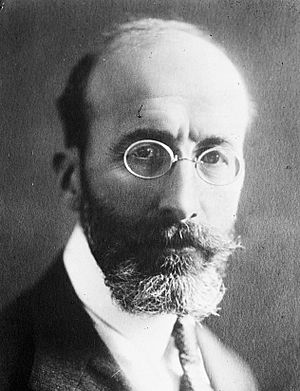Ramón Menéndez Pidal facts for kids
Quick facts for kids
Ramón Menéndez Pidal
|
|
|---|---|
 |
|
| Born | 13 March 1869 A Coruña, Spain
|
| Died | 14 November 1968 (aged 99) Madrid, Spain
|
| Nationality | Spanish |
| Alma mater | Complutense University of Madrid |
| Seat b of the Real Academia Española | |
| In office 19 October 1902 – 14 November 1968 |
|
| Preceded by | Víctor Balaguer i Cirera |
| Succeeded by | Vicente Enrique y Tarancón |
| Director of the Real Academia Española | |
| In office 23 December 1925 – 1939 |
|
| Preceded by | Antonio Maura |
| Succeeded by | José María Pemán |
| In office 4 December 1947 – 14 November 1968 |
|
| Preceded by | José María Pemán |
| Succeeded by | Vicente García de Diego |
Ramón Menéndez Pidal (born March 13, 1869 – died November 14, 1968) was a famous Spanish expert in language and history. He spent his life studying the history of the Spanish language. He also explored Spanish folklore (traditional stories and beliefs) and old folk poems. One of his favorite topics was the history and legends of El Cid, a famous Spanish warrior. He was nominated for the Nobel Prize many times, more than anyone else!
Contents
Who Was Ramón Menéndez Pidal?
Early Life and Family
Ramón Menéndez Pidal was born in A Coruña, a city in Galicia, Spain. His father was a lawyer and a judge. His mother was also from Asturias, a region in Spain. Ramón had two older brothers who were also very talented. His brother Juan studied folk poetry, and his brother Luis was a painter and art history professor.
Education and Marriage
Ramón studied at the University of Madrid. In 1899, he became a professor there, teaching about Romance studies (languages that came from Latin, like Spanish). He taught until he retired in 1939.
In 1900, he married María Goyri. María was an amazing woman! In 1896, she became the first Spanish woman to get a degree in Philosophy. Later, in 1909, she was the first woman to earn a doctorate (a very high university degree) in Spain that wasn't for medicine. For their honeymoon, Ramón and María traveled to the places mentioned in the Poem of the Cid (Cantar de Mio Cid).
Leading the Royal Spanish Academy
In 1901, Ramón Menéndez Pidal was chosen to join the Spanish Royal Academy (Real Academia Española). This is a very important group that looks after the Spanish language. He became its director in 1925. He stepped down in 1939, but was chosen again in 1947. He remained the director for the rest of his life.
His Amazing Research Work
In 1910, Ramón became the head of the language section at the Center for Historical Studies. This center was a place for important research in many fields. In 1914, the center started a journal called Revista de Filología Española. This journal became the most important one for studying Spanish language and old Spanish literature.
During the 1920s, Ramón Menéndez Pidal published many important books:
- Poesía juglaresca y juglares (1924) was about the history of minstrel poetry in medieval Spain. Minstrels were like traveling performers who sang stories.
- Orígenes del español (1926) was a key book about how the Spanish language started and grew.
- Flor nueva de romances viejos (1928) was a collection of old Spanish ballads (story-songs). It became very popular!
- La España del Cid (1929) was a huge, detailed book about the life of Rodrigo Díaz de Vivar, also known as "El Cid."
After the Spanish Civil War, Ramón kept working hard. He updated many of his earlier studies. He also wrote a big essay called "Los españoles en la Historia." This essay looked at the long struggle between different ideas in Spanish history. He also wrote more about ballads in Romancero Hispánico (1953). He even studied French epic poetry in La Chanson de Roland y el neotradicionalismo (1959).
Ramón Menéndez Pidal worked for many years on a complete history of the Spanish language. He wasn't able to finish it before he passed away. However, his work was published later as "Historia de la lengua española" (2005).
He was nominated for the Nobel Prize an incredible 154 times! In 1956 alone, he received 95 nominations for the Nobel Prize in Literature. Even though he never won, being nominated so many times shows how important his work was. He was also a member of important groups like the American Academy of Arts and Sciences.
Major Works
Here are some of Ramón Menéndez Pidal's most important books:
- La leyenda de los siete infantes de Lara (1896) - About a famous Spanish legend.
- Crónicas generales de España (1898) - General histories of Spain.
- Manual elemental de Gramática histórica española (1904) - A basic guide to Spanish historical grammar.
- El dialecto leonés (1906) - About the Leonese dialect of Spanish.
- Cantar de mio Cid: texto, gramática y vocabulario (1908–1912) - A deep study of the Poem of the Cid.
- Orígenes del español (1926) - About the origins of the Spanish language.
- La España del Cid (1929) - His major work on El Cid.
- La idea imperial de Carlos V (1938) - About the imperial idea of Emperor Charles V.
- Reliquias de la poesía épica española (1952) - Relics of Spanish epic poetry.
- Romancero hispánico (1953) - About Spanish ballads.
- En torno a la lengua vasca (1962) - A collection of works about the Basque language.
- El padre Las Casas: su doble personalidad (1963) - About Father Las Casas.
See also
 In Spanish: Ramón Menéndez Pidal para niños
In Spanish: Ramón Menéndez Pidal para niños


